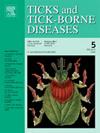微头蜱含有b细胞表位,可降低免疫牛蜱的生物适应性
IF 3.4
2区 医学
Q2 INFECTIOUS DISEASES
引用次数: 0
摘要
微头蜱是热带和亚热带地区牛的一种严重害虫,主要是因为它们除了作为巴贝斯虫病和无形体病的媒介外,还会减少肉和奶的产量,造成损失,并造成兽皮损伤。综合蜱虫控制必须包括使用抗蜱虫疫苗,以减少蜱虫种群并减轻与广泛使用杀螨剂相关的生态影响。为了开发改进的疫苗,对新的蜱虫抗原进行评估是必不可少的。Voraxin主要被描述为一种来自睾丸的蛋白质,在交配过程中从雄性转移到雌性,对刺激雌性蜱虫的充血和器官发育至关重要。本研究扩增并测序了R. microplus voraxin-α (voraxin-α),设计了4条具有预测b细胞表位的多肽,并对其免疫原性进行了评价。每个肽与一种商业佐剂混合,并接种到来自无蜱地区的两头牛身上,以证实它们是否真的具有免疫原性。采用间接ELISA法检测各肽的抗体反应。其中两种多肽具有免疫原性,并被选中进行进一步的免疫测试和实验感染,每个评估的多肽有1万只幼虫和2头牛。肽3免疫减少了17%的蜱虫存活率,14%的蜱虫产卵率和22%的蜱虫孵化率,肽4免疫减少了18%的蜱虫产卵率和18%的蜱虫孵化率。没有观察到对体重的影响。综上所述,以牛为食的蜱产生针对voraxin-α b细胞表位的特异性抗体,其存活率、产卵率和繁殖力均降低,这是与蜱适合度相关的重要生物学参数。需要进行疫苗试验,以评估该抗原是否可作为抗微致病菌的候选疫苗。本文章由计算机程序翻译,如有差异,请以英文原文为准。
Rhipicephalus microplus voraxin-alpha contains B-cell epitopes that reduce ticks’ biological fitness in immunized cattle
Rhipicephalus microplus ticks are a serious pest of cattle in tropical and subtropical regions, mainly due to the losses they cause by reducing meat and milk production, as well as causing hide damage, in addition to their role as vectors of babesiosis and anaplasmosis. Integrated tick control must include the use of anti-tick vaccines to reduce tick populations and mitigate the ecological impact associated with the extensive use of acaricides. To develop improved vaccines, evaluation of new tick antigens is essential. Voraxin, mainly described as a testes-derived protein, is transferred from males to females during copulation, and it is crucial for stimulating engorgement in female ticks and for the development of their organs. In this study, R. microplus voraxin-alpha (voraxin-α) was amplified and sequenced, four peptides with predicted B-cell epitopes were designed and their immunogenic properties were evaluated. Each peptide was mixed with a commercial adjuvant and inoculated into two cattle from a tick-free region to corroborate if they were truly immunogenic. The antibody responses to each peptide were assessed using indirect ELISA. Two peptides were immunogenic and were selected for further testing involving immunization and experimental infestation with 10,000 larvae and two cattle per evaluated peptide. Immunization with peptide 3 reduced tick survival in 17 %, oviposition in 14 % and egg hatching in 22 %, while peptide 4 impaired oviposition in 18 % and egg hatching in 18 %. No effect on weight was observed. In conclusion, ticks fed on cattle producing specific antibodies against voraxin-α B-cell epitopes, have a reduced survival, oviposition and fertility, which are important biological parameters, related to tick fitness. Vaccine trials are required to evaluate this antigen as a vaccine candidate against R. microplus.
求助全文
通过发布文献求助,成功后即可免费获取论文全文。
去求助
来源期刊

Ticks and Tick-borne Diseases
INFECTIOUS DISEASES-MICROBIOLOGY
CiteScore
6.90
自引率
12.50%
发文量
185
审稿时长
6-12 weeks
期刊介绍:
Ticks and Tick-borne Diseases is an international, peer-reviewed scientific journal. It publishes original research papers, short communications, state-of-the-art mini-reviews, letters to the editor, clinical-case studies, announcements of pertinent international meetings, and editorials.
The journal covers a broad spectrum and brings together various disciplines, for example, zoology, microbiology, molecular biology, genetics, mathematical modelling, veterinary and human medicine. Multidisciplinary approaches and the use of conventional and novel methods/methodologies (in the field and in the laboratory) are crucial for deeper understanding of the natural processes and human behaviour/activities that result in human or animal diseases and in economic effects of ticks and tick-borne pathogens. Such understanding is essential for management of tick populations and tick-borne diseases in an effective and environmentally acceptable manner.
 求助内容:
求助内容: 应助结果提醒方式:
应助结果提醒方式:


